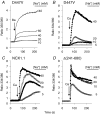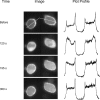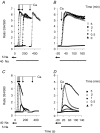Sodium-calcium exchange does not require allosteric calcium activation at high cytosolic sodium concentrations
- PMID: 16809364
- PMCID: PMC1995697
- DOI: 10.1113/jphysiol.2006.113910
Sodium-calcium exchange does not require allosteric calcium activation at high cytosolic sodium concentrations
Abstract
The activity of the cardiac Na(+)-Ca(2+) exchanger (NCX1.1) is allosterically regulated by Ca(2+), which binds to two acidic regions in the cytosolically disposed central hydrophilic domain of the NCX protein. A mutation in one of the regulatory Ca(2+) binding regions (D447V) increases the half-activation constant (K(h)) for allosteric Ca(2+) activation from approximately 0.3 to > 1.8 microm. Chinese hamster ovary cells expressing the D447V exchanger showed little or no activity under physiological ionic conditions unless cytosolic [Ca(2+)] was elevated to > 1 microm. However, when cytosolic [Na(+)] was increased to 20 mm or more (using ouabain-induced inhibition of the Na(+),K(+)-ATPase or the ionophore gramicidin), cells expressing the D447V mutant rapidly accumulated Ca(2+) or Ba(2+) when the reverse (Ca(2+) influx) mode of NCX activity was initiated, although initial cytosolic [Ca(2+)] was < 100 nm. Importantly, the time course of Ca(2+) uptake did not display the lag phase that reflects allosteric Ca(2+) activation of NCX activity in the wild-type NCX1.1; indeed, at elevated [Na(+)], the D447V mutant behaved similarly to the constitutively active deletion mutant Delta(241-680), which lacks the regulatory Ca(2+) binding sites. In cells expressing wild-type NCX1.1, increasing concentrations of cytosolic Na(+) led to a progressive shortening of the lag phase for Ca(2+) uptake. The effects of elevated [Na(+)] developed rapidly and were fully reversible. The activity of the D447V mutant was markedly inhibited when phosphatidylinositol 4,5-bisphosphate (PIP2) levels were reduced. We conclude that when PIP2 levels are high, elevated cytosolic [Na(+)] induces a mode of exchange activity that does not require allosteric Ca(2+) activation.
Figures







Similar articles
-
Sodium-dependent inactivation of sodium/calcium exchange in transfected Chinese hamster ovary cells.Am J Physiol Cell Physiol. 2008 Oct;295(4):C872-82. doi: 10.1152/ajpcell.00221.2008. Epub 2008 Jun 11. Am J Physiol Cell Physiol. 2008. PMID: 18550702 Free PMC article.
-
Allosteric activation of sodium-calcium exchange by picomolar concentrations of cadmium.J Physiol. 2005 Feb 15;563(Pt 1):105-17. doi: 10.1113/jphysiol.2004.077743. Epub 2004 Dec 20. J Physiol. 2005. PMID: 15611030 Free PMC article.
-
Inhibition of sodium-calcium exchange by KB-R7943: Dodecylamine and sphingosine in transfected Chinese hamster ovary cells.Cell Calcium. 2010 May;47(5):404-11. doi: 10.1016/j.ceca.2010.02.004. Epub 2010 Mar 5. Cell Calcium. 2010. PMID: 20206994
-
Ionic regulation of the cardiac sodium-calcium exchanger.Channels (Austin). 2008 Sep-Oct;2(5):322-8. doi: 10.4161/chan.2.5.6897. Channels (Austin). 2008. PMID: 18989096 Review.
-
Na:Ca stoichiometry and cytosolic Ca-dependent activation of NCX in intact cardiomyocytes.Ann N Y Acad Sci. 2007 Mar;1099:326-38. doi: 10.1196/annals.1387.060. Epub 2007 Feb 15. Ann N Y Acad Sci. 2007. PMID: 17303827 Review.
Cited by
-
The activation of Mucolipin TRP channel 1 (TRPML1) protects motor neurons from L-BMAA neurotoxicity by promoting autophagic clearance.Sci Rep. 2019 Jul 24;9(1):10743. doi: 10.1038/s41598-019-46708-5. Sci Rep. 2019. PMID: 31341250 Free PMC article.
-
Cerium-Doped Self-Assembling Nanoparticles as a Novel Anti-Oxidant Delivery System Preserving Mitochondrial Function in Cortical Neurons Exposed to Ischemia-like Conditions.Antioxidants (Basel). 2023 Feb 2;12(2):358. doi: 10.3390/antiox12020358. Antioxidants (Basel). 2023. PMID: 36829918 Free PMC article.
-
Na+/Ca2+ exchanger isoform 1 takes part to the Ca2+-related prosurvival pathway of SOD1 in primary motor neurons exposed to beta-methylamino-L-alanine.Cell Commun Signal. 2022 Jan 12;20(1):8. doi: 10.1186/s12964-021-00813-z. Cell Commun Signal. 2022. PMID: 35022040 Free PMC article.
-
The sodium-calcium exchanger is a mechanosensitive transporter.J Physiol. 2008 Mar 15;586(6):1549-63. doi: 10.1113/jphysiol.2008.151274. Epub 2008 Jan 31. J Physiol. 2008. PMID: 18238815 Free PMC article.
-
Sodium-dependent inactivation of sodium/calcium exchange in transfected Chinese hamster ovary cells.Am J Physiol Cell Physiol. 2008 Oct;295(4):C872-82. doi: 10.1152/ajpcell.00221.2008. Epub 2008 Jun 11. Am J Physiol Cell Physiol. 2008. PMID: 18550702 Free PMC article.
References
-
- Balla T. Phosphoinositide-derived messengers in endocrine signaling. J Endocrinol. 2006;188:135–153. - PubMed
-
- Blaustein MP, Lederer WJ. Sodium/calcium exchange: its physiological implications. Physiol Rev. 1999;79:763–854. - PubMed
-
- Chernysh O, Condrescu M, Reeves JP. Calcium-dependent regulation of calcium efflux by the cardiac sodium/calcium exchanger. Am J Physiol Cell Physiol. 2004;287:C797–C806. - PubMed
Publication types
MeSH terms
Substances
Grants and funding
LinkOut - more resources
Full Text Sources
Miscellaneous

